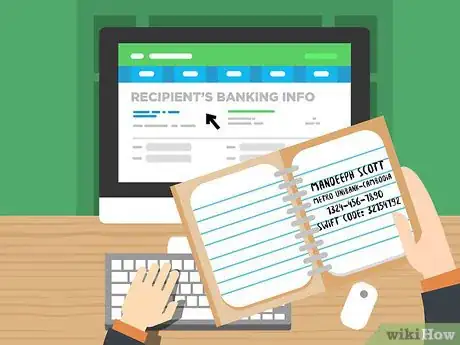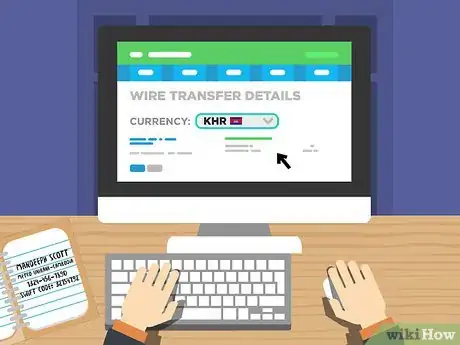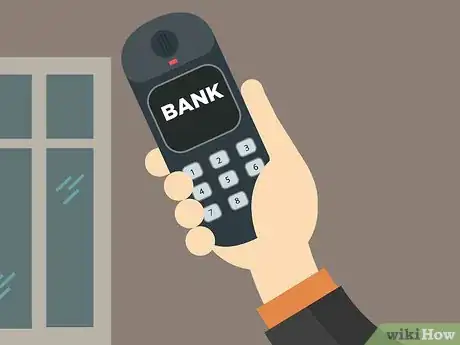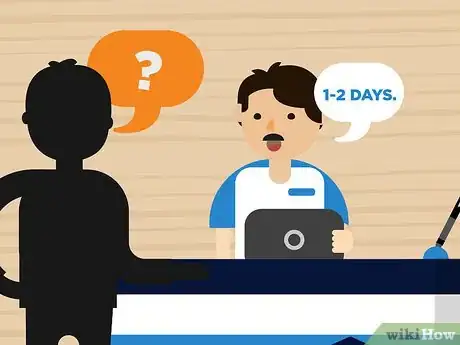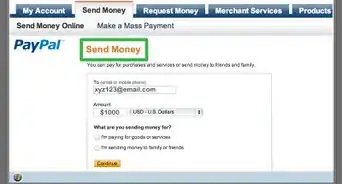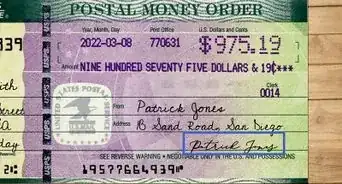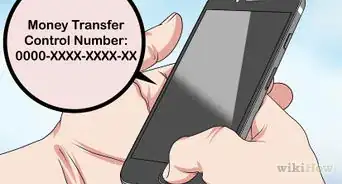This article was co-authored by Jill Newman, CPA. Jill Newman is a Certified Public Accountant (CPA) in Ohio with over 20 years of accounting experience. She has experience working as an accountant in public accounting firms, nonprofits, and educational institutions, and has also honed her communication skills via an MA in English, writing jobs, and as a teacher. She received her CPA from the Accountancy Board of Ohio in 1994 and has a BS in Business Administration/Accounting.
wikiHow marks an article as reader-approved once it receives enough positive feedback. In this case, 86% of readers who voted found the article helpful, earning it our reader-approved status.
This article has been viewed 645,311 times.
Wire transfers are a type of electronic funds transfer. They are usually considered the safest way to transfer funds, especially large amounts, to banks in countries overseas. Most large banks belong to a bank network in Belgium called the Society for Worldwide Interbank Financial Telecommunications (SWIFT)[1] that helps to verify and process financial messages, including wire transfers. In order to make a wire transfer to another country, you will need to get some information from the recipient and pay a fee to your bank to process the transfer.
Steps
Making an International Wire Transfer Online
-
1Log into your online banking profile. Before you can do an international wire transfer, you will need to have online banking services set up through your bank. Use your username and password to log into your online banking profile and complete a wire transfer from the comfort of your home.
-
2Look for a wire transfer option. Most major banks have an online wire transfer option. Do a search for international wire transfer options on your bank’s website, or look for the wire transfers section on the top toolbar of your bank’s website.
- If you cannot locate the online wire transfer page, call your bank for more information. They can direct you to the right page.
Advertisement -
3Activate your wire transfer limit. Some banks require you to specify a limit for international wire transfers, as transfers over a certain amount (usually $5,000) require you to call your bank to authorize a large transfer.[2]
- You may then need to confirm your identity by agreeing to have your bank send an access code to your cell phone. You will use this access code to activate your wire transfer limit. You can then start making international wire transfers online.
-
4Enter in the recipient's banking information. To complete an international wire transfer, you will need specific information from the recipient of the transfer, including:[3]
- The full name and address of the recipient’s bank.
- The recipient’s name, address, and account name (savings, checkings, money mart, etc.).
- The recipient’s account number, or International Bank Account Number (IBAN). Your recipient should be able to get this information from their bank, or from their banking statement. The recipient’s account number will depend on where their bank is located in the world. For example, an account number at a Canadian bank will appear differently than an account number at an Australian bank.
- The recipient’s bank’s SWIFT/BIC code. Your bank will require the recipient’s bank’s SWIFT/BIC code in order to identify which bank they are transferring your money to. The recipient should be able to get their bank’s SWIFT/BIC code by asking their bank for this information. Your bank may also be able to locate the recipient’s SWIFT/BIC code based on the recipient’s account information. Keep in mind that the SWIFT code will be different if the currency is anything other than US dollars.
-
5Specify the currency and amount of the transfer. The recipient’s country’s currency should appear automatically once you enter in the recipient’s information. But if you want to change the currency to a specific one, use the dropdown menu to adjust it. You can then choose the account you are transferring the money from, and enter in the amount of money you would like to wire transfer.
- Most banks encourage you to transfer money in the currency of the recipient’s country. If you are not sure what the recipient’s currency is, you can send the amount in U.S. or Canadian dollars.[4]
-
6Pay your bank’s fee for processing an international wire transfer. Most banks charge an international wire transfer fee ranging from $40-$50 per transfer. A list of fees for the top 10 U.S. banks can be found here.
- The receiving bank may also charge a small fee to process the wire transfer, ranging from $10-$20. The recipient of the transfer can ask their bank about the exact fee for receiving and processing a wire transfer. The recipient would then pay the processing fee for their bank to process the transfer.
- Keep in mind that there are several online options for wire transfers, such as PayPal or OFX. These services charge reasonable fees for international wire transfers. They can wire the money directly from your bank or you can set up an ACH direct debit.
-
7Check how long it will take for the wire transfer to go through. Most banks estimate between one and two days for wire transfers to go through. However, your bank should specify how long the transfer will take at the end of your online session.
- You can check the status of the wire transfer by logging into your online bank account and looking up the wire transfer. There should be a note when the transfer has gone through successfully.
Making an International Wire Transfer In-Person
-
1Call your bank to confirm they do wire transfers in-person. Most major banks are able to process wire transfers in-person at a branch location. However, you should confirm with your bank that they do this in-person service.
-
2Bring in the recipient’s banking information. To process the international wire transfer, you will need to show the banking attendant the following information:[5]
- The full name and address of the recipient’s bank.
- The recipient’s name, address, and account name (savings, checkings, money mart, etc.).
- The recipient’s account number, or International Bank Account Number (IBAN). Your recipient should be able to get this information from their bank, or from their banking statement. The recipient’s account number will depend on where their bank is located in the world. For example, an account number at a Canadian bank will appear differently than an account number at an Australian bank.
- The recipient’s bank’s SWIFT/BIC code. Your bank will require the recipient’s bank’s SWIFT/BIC code in order to identify which bank they are transferring your money to. The recipient should be able to get their bank’s SWIFT/BIC code by asking their bank for this information. Your bank may also be able to locate the recipient’s SWIFT/BIC code based on the recipient’s account information.
-
3Ask the bank teller to walk you through the wire transfer process. The teller should take the recipient’s information from you and ask you a series of questions to complete the wire transfer. You will need to confirm:[6]
- The currency in which you are sending the funds to the recipient.
- The account from which you are sending the funds to the recipient.
- The amount of funds you are transferring to the recipient.
- Most banks encourage you to transfer money in the currency of the recipient’s country. However, if you are not sure where the recipient is located or what currency the recipient would like the funds in, you can send the amount in U.S. or Canadian dollars.[7]
-
4Pay the international wire transfer fee. Most banks charge an international wire transfer fee ranging from $40-$50 per transfer. A list of fees for the top 10 U.S. banks can be found here. Ask your teller to confirm the fee amount before you complete the transfer.
- The receiving bank may also charge a small fee to process the wire transfer, ranging from $10-$20. The recipient of the transfer can ask their bank about the exact fee for receiving and processing a wire transfer. The recipient would then pay the processing fee for their bank to process the transfer.
-
5Check how long it will take for the wire transfer to go through. Once the teller completes the wire transfer process, she should let you know how long it will take for the bank to process the wire transfer and for the recipient to receive the funds. Most banks estimate between one and two days for international wire transfers to go through.
-
6Consider an international wire transfer through outside services. If you are concerned about your bank’s fee for international wire transfers, you can go through another wiring service like Western Union. The fees from Western Union are usually less than the fees charged by your bank, around $10-$15 per transfer. But the transfer may take more time if you use an outside service like Western Union instead of your bank.[8]
References
- ↑ http://www.swift.com/index.page?lang=en
- ↑ https://www.commbank.com.au/support/faqs/681.html
- ↑ https://www.commbank.com.au/support/faqs/681.html
- ↑ https://www.bankofamerica.com/foreign-exchange/wire-transfer.go
- ↑ https://www.commbank.com.au/support/faqs/681.html
- ↑ https://www.commbank.com.au/support/faqs/681.html
- ↑ https://www.bankofamerica.com/foreign-exchange/wire-transfer.go
- ↑ http://www.westernunion.ca/WUCOMWEB/priceShopperRedirectAction.do?method=load
Expert Q&A
Did you know you can get expert answers for this article?
Unlock expert answers by supporting wikiHow
-
QuestionDo I need to notify the IRS if I make an international transfer of $25,000?
 Michael R. LewisMichael R. Lewis is a retired corporate executive, entrepreneur, and investment advisor in Texas. He has over 40 years of experience in business and finance, including as a Vice President for Blue Cross Blue Shield of Texas. He has a BBA in Industrial Management from the University of Texas at Austin.
Michael R. LewisMichael R. Lewis is a retired corporate executive, entrepreneur, and investment advisor in Texas. He has over 40 years of experience in business and finance, including as a Vice President for Blue Cross Blue Shield of Texas. He has a BBA in Industrial Management from the University of Texas at Austin.
Business Advisor A wire transfer is not a reportable transaction under Bank Secrecy Act compliance. There is no need to notify the IRS for any wire transfer. The transferring bank must report all wire transfers over $3000 in their Currency Transaction Reports filed with the Financial Crimes Enforcement Network, but the customer is often unaware of the report.
A wire transfer is not a reportable transaction under Bank Secrecy Act compliance. There is no need to notify the IRS for any wire transfer. The transferring bank must report all wire transfers over $3000 in their Currency Transaction Reports filed with the Financial Crimes Enforcement Network, but the customer is often unaware of the report. -
QuestionWhat can I do if the money is not in an account 2 weeks after sending it?
 Jill Newman, CPAJill Newman is a Certified Public Accountant (CPA) in Ohio with over 20 years of accounting experience. She has experience working as an accountant in public accounting firms, nonprofits, and educational institutions, and has also honed her communication skills via an MA in English, writing jobs, and as a teacher. She received her CPA from the Accountancy Board of Ohio in 1994 and has a BS in Business Administration/Accounting.
Jill Newman, CPAJill Newman is a Certified Public Accountant (CPA) in Ohio with over 20 years of accounting experience. She has experience working as an accountant in public accounting firms, nonprofits, and educational institutions, and has also honed her communication skills via an MA in English, writing jobs, and as a teacher. She received her CPA from the Accountancy Board of Ohio in 1994 and has a BS in Business Administration/Accounting.
Financial Advisor
-
QuestionIs the transfer rate better when sending in home country or changing to the recipient's currency?
 Michael R. LewisMichael R. Lewis is a retired corporate executive, entrepreneur, and investment advisor in Texas. He has over 40 years of experience in business and finance, including as a Vice President for Blue Cross Blue Shield of Texas. He has a BBA in Industrial Management from the University of Texas at Austin.
Michael R. LewisMichael R. Lewis is a retired corporate executive, entrepreneur, and investment advisor in Texas. He has over 40 years of experience in business and finance, including as a Vice President for Blue Cross Blue Shield of Texas. He has a BBA in Industrial Management from the University of Texas at Austin.
Business Advisor
About This Article
To make an international wire transfer, start by logging into your online banking profile. Then, locate the wire transfer option and enter the recipient's banking information, including the full name and address of the bank, the recipient's account number, and the bank's SWIFT/BIC code. Once you've entered this information, specify the currency and amount that you want to transfer and then pay your bank's processing fee before submitting the transfer. To learn how to make an international wire transfer in person, scroll down!



